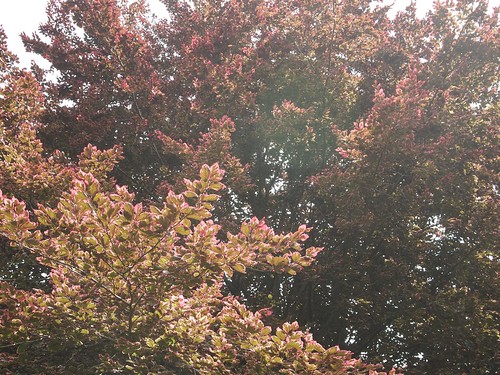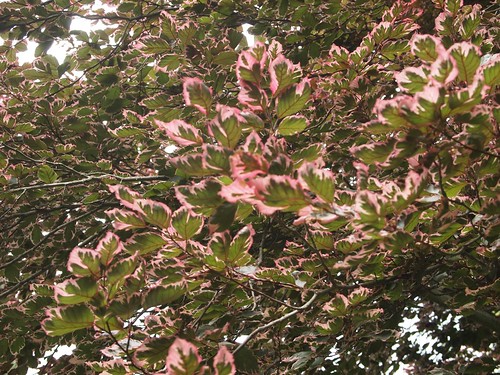Interesting Plant: Tricolor Beech (Fagus sylvatica Purpurea Tricolor)
I came across a couple of these trees on our recent Ohio trip and was struck by their beauty every time. According to my reading, they are a bit slow growing, but they would be well worth the time for such a beautiful specimen tree. After only a quick look, it appears that the leaves start our green throughout, but then, as the leaf ages the chlorophyll along the edges of the leaf dies out, revealing the read coloration and almost turning completely transparent. When the sun shines through the leaves it almost seems to glow. I probably don’t have a place for this tree out here in California, but were I to have a garden in Ohio, I would almost certainly add one of these Beech trees as a focal point.
Interesting Plant: Tricolor Beech – Fagus sylvatica Purpurea Tricolor
“Fagus sylvatica, the European Beech or Common Beech, is a deciduous tree belonging to the beech family Fagaceae.
It is a large tree, capable of reaching heights of up to 49 m (160 ft) tall[2] and 3 m (10 ft) trunk diameter, though more typically 25–35 m (80–115 ft) tall and up to 1.5 m (5 ft) trunk diameter. A 10-year-old sapling will stand about 4 m (13 ft) tall. It has a typical lifespan of 150 to 200 years, though sometimes up to 300 years. The appearance varies according to its habitat; in forest conditions, it tends to have a long, slender light-gray trunk with a narrow crown and erect branches, in isolation with good side light the trunk is short with a large and widely spreading crown with very long branches.” — Wikipedia
Do you have suggestions for the Interesting Plant series? Share your favorites with me!
More information on Tricolor Beech (Fagus sylvatica Purpurea Tricolor)
- Beech at Wikipedia
- Fagus sylvatica ‘Purpurea Tricolor’ at Missouri Botanical Garden
- Tri-colored European Beech Fagus sylvatica ‘Roseomarginata’ discussion at Dave’s Garden
- Fagus sylvatica ‘Purpurea Tricolor’ at Friends of Trees
Previously in the Interesting Plant series:
- Climbing Hydrangea (Hydrangea anomala petiolaris)
- Eremurus ‘Lemon Meringue’
- Lupine “Sunrise” (Lupinus hartwegii)
- Chinese Fringe Flower (Loropetalum chinense)
- Streptocarpus ‘Harlequin Blue’
- Nigella damascena (love-in-a-mist, ragged lady)
- Epiphyllum (Orchid Cactus)
- Sempervivum ‘Westerlin’
- Gladiolus ‘Kings Lynn’
- Hosta sieboldiana ‘Dorothy Benedict’
- Begonia “Escargot”
- Asparagus Pea (Psophocarpus tetragonolobus)
- Rosa banksiae (Lady Banks’ Rose)
- Primula ‘Victoriana Silver Laced Black’
- Oxalis versicolor
- Poached Egg Plant (Limnanthes douglasii)
- Parisian Carrots
- Fritillaria imperialis Rubra Maxima
- Clematis “Fascination”
- Swiss Chard “Bright Lights”
- Georgia Rattlesnake Melon
- Dianthus Barbathus “Green Ball” or “Green Trick”
- Coleus “Religious Radish”
- Black Forest Calla Lily
- Black Bamboo



